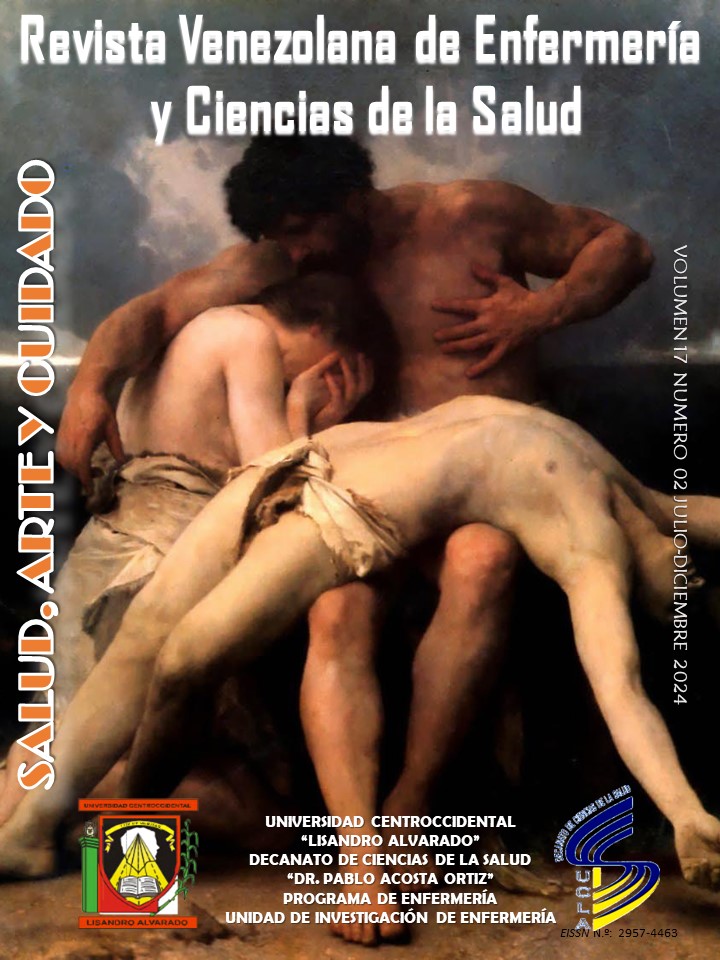Características clínico epidemiológicas del paciente pediátrico con neutropenia febril en quimioterapia
DOI:
https://doi.org/10.5281/zenodo.13147171Keywords:
febrile neutropenia, infections, chemotherapyAbstract
Febrile neutropenia is the decrease in the absolute neutrophil count below 1.000, associated with fever, secondary to chemotherapy compliance. The aim of this study was to determine the clinical and epidemiological characteristics of pediatric patients with febrile neutropenia during chemotherapy, attended at the Deconcentrated Service of the University Pediatric Hospital Dr. Agustín Zubillaga. The study was descriptive and cross-sectional. The population consisted of pediatric oncology patients. The sample consisted of 67 hospitalized patients who received chemotherapy and presented febrile neutropenia in the study period from January 2018 to January 2023, who met the inclusion criteria. The data collection technique was direct observation of the histories of the patients who constituted the sample and the instrument was a structured form developed for this research. The results were the following; of the epidemiological characteristics, children from 2 to 5 years old predominate, the largest group corresponds to the male sex and they come from the state of Lara, a high percentage of the population was classified in Graffar IV. The clinical characteristics predominate in this order; respiratory symptomatology, skin and soft tissues, gastrointestinal alterations and urinary, in a high percentage of the population, febrile neutropenia was 10-12 days after the completion of chemotherapy, with benefits after the use of antibiotic therapy and cure of symptoms. In paraclinical studies, the findings indicate the absolute value of neutrophils is relevant criteria of severity, likewise, the early performance of cultures and laboratory studies in the presence of fever in post chemotherapy patients are of great importance, since it allows the early establishment of therapy and therefore lower incidence of morbidity and mortality.
Downloads
References
Ahmed, N, El-Mahallawy, H., Ahmed, I., Nassif, S., El-Beshlawy, A., El-Haddad, A. (2007). Early hospital discharge verss continued hospitalization in febrile pediatric cancer patients with prolonged neutropenia: A randomized, prospective study. Pediatr Blood Cancer. 49(6):786-92. 3
Aruachán S, González M, Lobatón J y cols (2020), Realizaron la caracterización clínico patológica y hallazgos microbiológicos de la neutropenia febril en pacientes oncohematológicos en una clínica privada en la ciudad de Montería – Colombia Rev Col Hematol Oncol, 7 (2) Julio-diciembre
Aurenty L, Moya M, Pereira A, y cols. (2022) En su estudio Hora Dorada de neutropenia febril en cáncer pediátrico Hospital de Niños “J. M. de los Ríos”
Barrera L y Ramírez M, (2021); Perfil clínico-epidemiológico de pacientes pediátricos con neutropenia febril con diagnóstico de cáncer, en clínicas de tercer nivel de la ciudad de Pereira Risaralda.
Dang-Tan, T. y Franco, L. (2007). EL. Diagnosis delays in childhood cancer: a review. Cancer. 2007; 110:703-13.
Düzenli Kar et al., (2018), The Frequency of Metabolic Syndrome and Serum Osteopontin Levels in Survivors of Childhood Acute Lymphoblastic Leukemia.Journal of Adolescent and Young Adult Oncology.Aug 2018.480-487.
Fuentes, L., Flores, M., Iglesias, A., Luzuriaga, A., Rendón, N., et. al. (2018). Características de la leucemia linfoblástica aguda y neutropenia febril en niños y adolescentes atendidos en un hospital de Guayaquil, Ecuador. Revista Peruana de Medicina Experimental y Salud Publica, 35(2), 272-278.
Hibirmas I y Acosta Y. (2013). Realidades del cáncer infantil en Venezuela. Un estudio desde las Políticas Públicas. [Internet]. 2013; 976-001 [Consultado: 8 gosto 2022]. Disponible en: en http://saber.ucv.ve/handle/123456789/4258.
Íñigo, H., Domínguez, R. (2020). Neutropenia febril posquimioterapia. Estancia hospitalaria y experiencia en nuestro medio. Anales de Pediatría. 92, (3) 141-146.
Manterola, A., Romero, P., Martínez, E., Villafranca, E., Arias, F., Domínguez, M., y Martínez, M. (2004). Neutropenia y fiebre en el paciente con cáncer. Anales del Sistema Sanitario de Navarra 27(Supl. 3), 33-43.
Pacheco D, PeregrinoJ, Rosas L, y cols (2019) Tratamiento en niños con neutropenia febril Revista Médica del Instituto Mexicano del Seguro Social, Vol. 57, Núm. 2 (2019).
Panebianco, M.C., y García, M. Características clínicas de los tumores oncológicos pediátricos en pacientes que acuden al Servicio Desconcentrado Hospital Universitario Pediátrico Dr. “Agustín Zubillaga”, Barquisimeto estado Lara. Trabajo de grado no publicado. Universidad Central de Venezuela.
Santolaya ME, Alvarado T, Queiroz-Telles F, Colombo AL, Zurita J, Tiraboschi IN, et al. Active surveillance of candidemia in children from Latin America: a key requirement for improving disease outcome. Pediatr Infect Dis J 2013; August 29.
Published
How to Cite
Issue
Section

This work is licensed under a Creative Commons Attribution-NonCommercial-ShareAlike 4.0 International License.
Derechos del/de autor/es a partir del año de publicación
Esta obra está bajo la licencia:
Creative Commons Reconocimiento-NoComercial-CompartirIgual 4.0 Internacional (CC BY-NC-SA 4.0)
Las opiniones expresadas por los autores no necesariamente reflejan la postura del editor de la publicación ni de la UCLA. Se autoriza la reproducción total o parcial de los textos aquí publicados, siempre y cuando se cite la fuente completa y la dirección electrónica de esta revista. Los autores(as) tienen el derecho de utilizar sus artículos para cualquier propósito siempre y cuando se realice sin fines de lucro. Los autores(as) pueden publicar en internet o cualquier otro medio la versión final aprobada de su trabajo, luego que esta ha sido publicada en esta revista.







